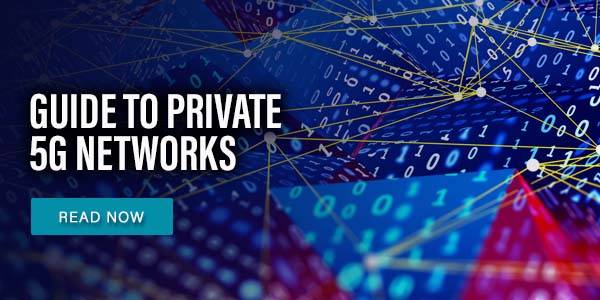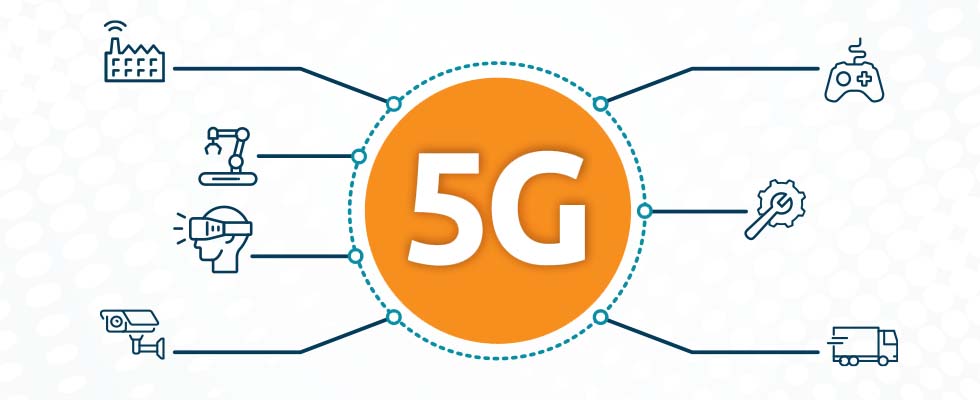Key Takeaways
- Private 5G networks are secure, restricted communication networks used by organizations to protect data and ensure high performance at scale, offering advantages over Wi-Fi in security, coverage, and performance.
- Private 5G networks offer enhanced security, improved performance, custom configuration, stronger access controls, and increased reliability compared to public networks.
- Challenges of private 5G networks include securing licensed spectrum, high implementation costs, and complex maintenance requirements.
- Organizations can choose between network slicing (renting a portion of a telecom network) and managed private networks (administered by a third party) for private 5G deployment.
- Private 5G network use cases include supporting IoT and IIoT, enabling digital twins, and facilitating automated guided vehicles (AGVs) in environments like ports.
To move as fast as they can at scale while protecting mission-critical data, more and more organizations are investing in private 5G networks, also known as private cellular networks or just “private 5G” (not to be confused with virtual private networks, which are something totally different).
According to one recent report, the private 5G network market brought in $2.6 billion in 2022. By 2032, it’s expected to generate $129.6 billion, growing 48.2% each year in between.
This blog explores what private 5G networks are, the benefits and challenges inherent in private networks, and some popular private 5G network use cases.
Table Of Contents
- What is a private 5G network?
- What makes a 5G private network ‘private’?
- Private 5G vs Wifi
- What are the benefits of private 5G networks?
- What are the challenges of private 5G networks?
- What are the different types of private networks?
- Private 5G Network Use cases
- Thinking about building or deploying a private 5G network?
What is a private 5G network?
A private 5G network is a secure, restricted communication network that includes base stations, radio access networks, and other components found in public carrier networks but on a smaller scale confined to a specific organization, business, or campus.
Unlike public networks — like your cellular carrier or the wireless network you connect to while you enjoy your Starbucks — private networks are only accessible to a specific set of authorized users and devices. This is why today’s leading enterprises are increasingly deploying this type of infrastructure: Private cellular networks help protect and secure all of the data exchanged within them because phone networks are fundamentally more secure than WiFi.
Although they’re still a bit of a niche thing, private cellular networks are appearing more frequently within large-scale enterprises, educational institutes, and government organizations to facilitate secure communication, data sharing, and collaboration, and also to ensure high performance at scale. One more practical advantage is that each 5G base station can cover the kind of surface area you’d need around 20 WiFi stations for, which declutters infrastructure.
In an age where the average data breach sets U.S. organizations back $4.45 million and downtime can eclipse $5 million per hour, it comes as no surprise that more and more IT decision-makers are opting to secure their infrastructure, support their devices, and protect their data with private cellular networks.
What makes a 5G private network ‘private’?
When organizations choose to deploy private 5G networks, they generally have two options: getting a fully self-hosted radio access network (RAN) in a box or going the network slicing route and renting a dedicated portion of a telecom company’s network. In either case, the organization controls who and which devices can connect using SIM cards and access controls. The network is entirely encrypted, too, preventing unauthorized individuals from interpreting any data.
Private 5G vs Wifi
Both Private 5G and Wi-Fi offer wireless network services, but they each have distinct characteristics and purposes.
5G is not meant to replace Wi-Fi; rather, they complement each other, each with its own strengths depending on the context and application.
Wi-Fi is a widely recognized standard used by millions of devices globally, making it cost-effective to implement and manage. However, it has limitations when used as the sole connectivity solution:
Security
While Wi-Fi can be vulnerable to threats like malware, which might exploit stolen or forged credentials, private 5G provides encrypted communications. Access to private 5G networks requires a valid SIM card in the device, enhancing security.
Coverage
Deploying Wi-Fi in expansive areas like airports or event venues can be complex and costly due to the need for numerous access points. In remote locations lacking Wi-Fi infrastructure, 5G and 4G can offer broader coverage without requiring extensive cabling.
Performance
Both Wi-Fi and 5G operate on shared frequency spectrums. Wi-Fi can face performance issues when distributing bandwidth among multiple devices and is susceptible to interference and fluctuations based on usage. Additionally, frequent handoffs between access points can lead to delays and connection drops.
While Wi-Fi theoretically can achieve 5G-like speeds, it falls short in providing the consistent performance and reliability that 5G offers, including low latency, higher speeds, and increased bandwidth.
In summary, while Wi-Fi remains suitable for many current computing devices, those equipped for 5G can often achieve significantly faster performance when connected to a 5G network. Both private 5G and Wi-Fi are expected to coexist, supporting the diverse connectivity needs of enterprises and organizations in the future.
What are the benefits of private 5G networks?
From improving security and protecting data to facilitating stronger, more productive collaboration and stronger user experiences, there’s a lot to like about private cellular networks.
1. Enhanced security
By providing telco-grade security, encryption, and complete control over infrastructure, private networks help protect crown-jewel data against unauthorized access and cyberattacks. This heightened security ensures the confidentiality and integrity of sensitive information — including trade secrets, intellectual property, personally identifiable information (PII), and sensitive health records and payment data — which is critical when it comes to protecting organizational assets and maintaining user trust.
2. Improved performance
Private networks are powered by dedicated resources — including licensed spectrum, base stations, core networks, antennas, and backhaul connectivity — which accelerate data transfer speeds and optimize network performance. They are especially useful for large campuses such as airports or ports, where space is limited and many of the devices are continuously moving, which causes problems for WiFi. Organizations that use private cellular networks don’t have to worry about running into performance issues during peak traffic periods. With reduced congestion and latency, users experience faster, more reliable connectivity — even as they move outside across a corporate campus — which enhances efficiency and productivity within an organization while improving user experiences for customer-facing applications. At the same time, it also makes it easier to orchestrate IIoT devices that have to move around and between buildings.
3. Custom configuration
Since organizations that deploy private networks have complete control over the infrastructure, they can customize the configuration to meet their unique needs. As a result, businesses can optimize network settings, prioritize traffic, and implement protocols that align with their requirements and use cases. This, in turn, enables them to set up their network in a way that best supports organizational workflows, increasing productivity and operational efficiency.
4. Stronger access controls
Private networks offer granular control over user access, allowing organizations to define and manage permissions to keep bad actors at bay. Such control ensures only authorized users and devices can get to sensitive data and critical network resources, thereby minimizing the risks associated with internal security breaches and maintaining a secure and compliant network environment.
5. Increased reliability
With a private network, organizations can establish highly available, reliable, and consistent communication channels that deliver performance at scale. This reliability is particularly beneficial for critical business operations, facilitating seamless collaboration, data sharing, and real-time interactions among users while avoiding the potential disruptions often associated with WiFi networks (e.g., performance degradations due to high concurrent usage or distance from hotspots).
What are the challenges of private 5G networks?
While the benefits of private networks speak for themselves, this type of infrastructure is not without its share of challenges.
Securing licensed spectrum
Licensed spectrum is crucial for private 5G networks as it ensures exclusive access to frequency bands, offering reliability and security for critical operations. However, securing licensed spectrum can be challenging as it’s often already owned by public carriers, leaving limited options for private network deployment. This scarcity of available spectrum can lead to competition and high costs for organizations seeking to acquire licenses. Some regulators, however, have kept spectrum back for private networks.
High implementation costs
Deploying a private cellular network you’re planning to manage involves substantial upfront costs. If you host your own network, you have to pay for hardware, software, and security infrastructure, and you also need space to store servers and absorb the associated energy costs.
While network slicing enables you to use a portion of a telecom provider’s network, it can still carry a high price tag. So, if you’re thinking about deploying a private cellular network, be prepared to allocate significant resources to establish and manage the infrastructure. While this might be easy for deep-pocketed enterprises, high implementation costs put private cellular networks out of reach for most smaller businesses.
Complex maintenance requirements
Fully private networks require ongoing maintenance and updates to ensure optimal performance and security. Unlike the public cloud, organizations have to handle this work internally. Unfortunately, this complexity can strain IT resources, requiring skilled personnel to handle troubleshooting, updates, and other potential issues.
Since not every organization has dedicated resources to deploy toward such efforts, private 5G network maintenance requirements can pose a challenge for some businesses.
What are the different types of private networks?
Though they largely provide the same benefits, organizations can choose between two types of private networks:
- A private network via network slicing, which entails splitting off a fragment of an operator’s network into a virtual network, thus creating a dedicated network for a specific organization or department. Since legally running your own private 5G network requires a regulator to approve a frequency for you, this option enables organizations to take advantage of “better than standard” offerings without having to navigate regulatory landmines.
- A managed private network, or a private network that’s administered by a third-party provider. While there are some instances of small-scale private RAN applications, they are typically confined to austere environments where there’s no service of any kind or a compelling legal or military interest that requires a standalone network. While still a relatively nascent technology, managed private 5G networks are best suited for industrial-scale applications (e.g., large automobile manufacturers or ports).
Private 5G Network Use cases
To make the most out of private networks, organizations need to ensure they bake real-time data processing capabilities into the foundation of their architecture. By doing so, they can take advantage of several transformative use cases.
IoT and IIoT
Private networks play a pivotal role in supporting Internet of Things (IoT) and enterprise IoT use cases and initiatives, particularly those that involve edge computing and real-time data transfer. In IoT applications, devices generate massive amounts of data, and organizations must be able to process it rapidly to leverage it to its full potential. Since private networks support efficient communication between IoT devices and edge computing resources, organizations can use this infrastructure to analyze and act upon sensor data in real time to optimize production processes, perform predictive maintenance, and otherwise make data-driven decisions faster.
Digital twins
Private cellular networks are instrumental in the implementation of digital twins, which are virtual replicas of physical entities or systems and use a ton of bandwidth. Digital twins require robust and secure connectivity to synchronize real-world data with their virtual counterparts. By ensuring a dedicated and reliable communication channel for real-time data exchange between the physical object and its digital twin, private 5G networks are ideal for managing such virtual representations.
Automated guided vehicles (AGVs)
Private 5G networks are well-suited to use cases involving AGVs. For example, the ultra-low latency and high reliability of these networks can help AGVs work seamlessly in port environments thanks to real-time communication and control — something that’s crucial for coordinating AGC movements efficiently and safely.
Additionally, the high throughput and capacity of private 5G networks support the transfer of large volumes of data generated by AGVs, including sensor data, video streams, and telemetry, facilitating advanced analytics, machine learning, and decision-making algorithms to optimize port operations.
Beyond this, 5G network slicing capabilities enable organizations to segment network resources and prioritize AGV traffic, ensuring consistent performance and reliability for critical applications. With the ability to customize and manage dedicated network infrastructure, port operators can deploy private 5G networks tailored to their specific requirements, offering scalability, security, and flexibility to support current and future AGV deployments.
Thinking about building or deploying a private 5G network?
Unlocking the full promise of a private 5G network is only possible when you have real-time data processing capabilities. Learn why private cellular networks require real-time data processing.



